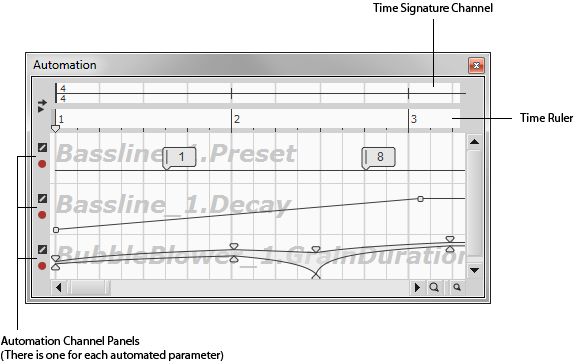| AudioMulch Help > Getting Started | Previous Next |
Introducing Other Main Features of AudioMulch
Now you've learned about patches, contraptions and the clock (see the other pages in this section if you haven't already), there are several other main features of AudioMulch that you should be aware of. These include the Metasurface, Automation, and MIDI control of contraption parameters. On this page we give a brief overview of these features, tell you what they're useful for and who might want to use them.
Metasurface

The Metasurface lets you change multiple contraption parameters at once, just by moving the mouse. You can store snapshots of parameter settings for an entire AudioMulch (.amh) document and selectively choose which of these parameters will be addressed by the Metasurface. Once you've stored the snapshots you can either recall them in their original state, or you can morph between them, resulting in a smooth transition from one snapshot to another. To do this, you place the snapshots on the Interpolation Surface and click and drag between them with the mouse.
The Metasurface can be particularly useful if you like to improvise, or work with fluid sonic states. It can be good for live performers and people working with installations and theatre sound design.
To read more about the Metasurface and for instructions on how to use it, visit the Metasurface page of this Help File.
Automation

With Automation you can define the way selected contraption parameters change over time. You automate contraption parameters in the Automation Pane. Each automated parameter has its own Automation Channel Panel that you can edit. Automation can be applied to most contraption parameters including the values of knobs, sliders, check boxes and contraption Presets. It can also be applied to some global parameters such as clock tempo and Metasurface location.
Automation is particularly useful for people who like pre-planning aspects of their work, including musicians, composers and studio music producers.
To read more about Automation and for instructions on how to use it, visit the Automation Overview and Editing an Automation Sequence pages of this Help File.
MIDI control, routing and clock synchronization
MIDI (Musical Instrument Digital Interface) is the industry standard used by computers and electronic music devices to talk to each other. Combining AudioMulch with MIDI devices expands the ways in which you can perform, giving you a physical control interface beyond the computer screen and the mouse.
AudioMulch's MIDI capabilities span three areas. You can:
1. Control contraption parameters using MIDI controllers
In AudioMulch you can use MIDI to control contraption parameters. A knob, slider or other MIDI controller can be quickly and easily mapped to a parameter using AudioMulch's Quick-Mapping feature. You can also create and fine tune your mapping settings via the Parameter Control window.
This feature is particularly useful for anyone who uses MIDI in live performance, installation artists and theatre sound designers.
To learn more about MIDI Control and for instructions on how to set it up and use it, visit Controlling AudioMulch Parameters from MIDI.
2. Work with virtual MIDI instrument and MIDI processing plugins
You can use AudioMulch to host VST and Audio Unit virtual instrument plugins. You can route MIDI data between plugins in the Patcher Pane, and use MIDI processing and sequencing plugins to manipulate MIDI data. Use MidiIn contraptions to bring MIDI data into your patches from external MIDI controllers (keyboards, drum pads, etc.), and use MidiOut contraptions to send MIDI data from plugins out to hardware devices (synthesizers, drum machines).
This feature is particularly useful for musicians who use MIDI virtual instrument plugins in live performance, such as keyboardists and percussionists.
To learn more about using MIDI with virtual instruments, and MIDI processing and sequencing plugins, visit Routing MIDI in the Patcher Pane.
3. Synchronize AudioMulch's clock with other MIDI devices
With AudioMulch's MIDI clock synchronization feature you can synchronize AudioMulch to any device that can send or receive MIDI clock sync (e.g. drum machines, groove boxes, hardware MIDI sequencers, or other software). This means that the tempo/rhythmic timing of AudioMulch and the external device stay locked in tight synchronization.
This feature is particularly useful for musicians who perform live, rhythmic electronic music that combines AudioMulch with hardware sequencers, synthesizers and drum machines.
To learn more about using AudioMulch's MIDI clock synchronization features, visit Synchronizing AudioMulch to Other MIDI Hardware and Software.
See Also
- Using Contraption Property Editors
- Using Contraption Controls
- The Metasurface
- Automation Overview
- Editing an Automation Sequence
- Controlling AudioMulch Parameters from MIDI
- Routing MIDI in the Patcher Pane
- Synchronizing AudioMulch to Other MIDI Hardware and Software
| Previous Next |
